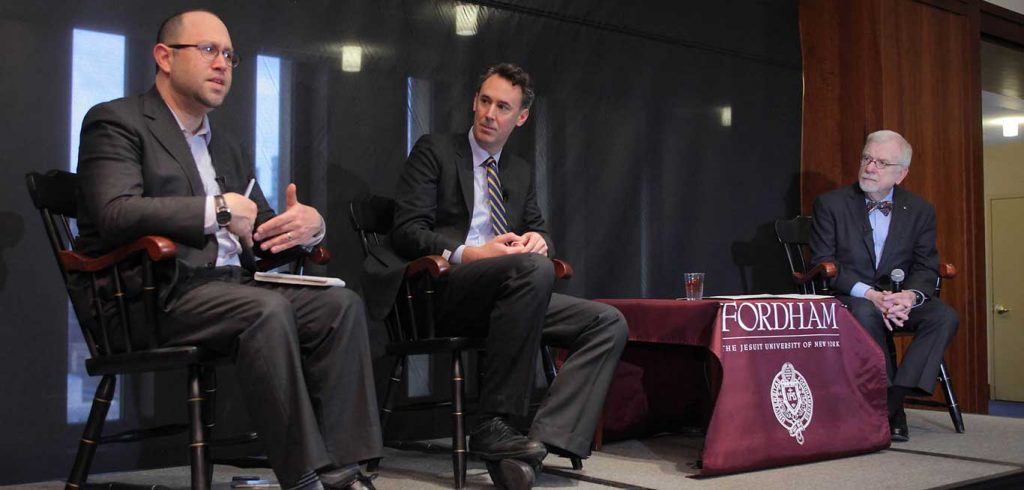Two people who played an integral part on the communications team in former Mayor Michael Bloomberg’s administration revealed what it was like to serve during “the golden age of policy.”
Stu Loeser, who served as press secretary for Bloomberg, and Frank Barry, who was the mayor’s director of public affairs and chief speechwriter, spoke at Fordham on March 21 in the latest installment of The Bloomberg Years, an Oral Archive on Governance in New York City.
Moderator and host William Baker, PhD, journalist-in-residence and Claudio Acquaviva, SJ, Chair at the Graduate School of Education, quizzed the two on issues from what an average work day entailed to big-picture topics like the framing of Bloomberg’s quest for a third term.
Barry said it was exhilarating to work for someone who was willing to publicly criticize and praise the positions of both major political parties, depending on the strength of the ideas.
“This seems like a fairly obvious thing to do, but in politics it’s actually a pretty rare thing. So for a major political figure to give voice to a kind of pragmatic centrism that spoke honestly about the pluses and minuses of both parties was pretty rare,” he said.
Loeser, who worked in the administration for seven years, said one challenge of explaining Bloomberg’s decisions was that—although many assumed he’d govern the city like a business—he understood that you can’t simply abandon ventures that are unprofitable, as is done in the private sector.
“Only in retrospect … what we can see is, in governing, there was capitalism at the center of the administration, [but]the currency was ideas. Mike Bloomberg was interested in great ideas that would transform the city,” he said.
“When you decide where to go out to dinner, some people might say ‘I feel like Chinese tonight, or Italian.’ The Mike Bloomberg theory would be, ‘I want to go to the best possible restaurant, and I don’t care if it’s Chinese or Italian.’”
The appointments of Iris Weinshall and Janette Sadik-Khan as heads of the Department of Transportation were proof, he said, of a willingness to listen to different approaches to the same problem. During her tenure, Weinshall instituted no-turning zones on major thoroughfares in Manhattan as a way to alleviate congestion; Sadik-Khan, as her successor, turned over roads to bikers and pedestrians.
“These are totally divergent paths, but they were both given attention because they were both great ideas, he said.
When it came to working with outside media, both men agreed they held unique jobs for two reasons; the volume of media outlets based in the city is extraordinary, and New York City’s mayor has a stronger national presence compared to other major American city mayors.
Loeser joked that in other places, one only need to worry about not being corrupt, while in New York, a fight over the preservation of 2 Columbus Circle—the so-called Lollipop Building—was so vociferous it was as if the administration was “trampling puppies.”
Frank said what made Bloomberg unique was he was incredibly comfortable in his own skin and never tried to be or to sound like someone he wasn’t. This was never more evident than at the 2003 funeral of James Davis, a member of the city council who was assassinated.
“Mike Bloomberg got up, and he was Mike Bloomberg. He didn’t try to be anyone else; he didn’t try to imitate or emulate someone else’s speaking style. And he spoke very honestly and sincerely to the family about the loss,” he said.
“Something really not seen by the public was how good he was at eulogies. The way he was able to connect with families and speak with them in a personal way always impressed us.”


